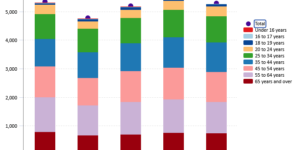“We’ll see more change in the next 25 years than we’ve seen in the last 100,” a futurist told insurance professionals at a meeting in late 2014. Jack Uldrich, speaking at a Casualty Actuarial Society meeting, highlighted sensors, robotics, nanotech, big data and 3-D printing among tech trends to watch back then.
 Jack Uldrich is a leading global futurist and author of 11 books, including “Foresight 2020: A Futurist Explores the Trends Transforming Tomorrow.” He is a frequent speaker on technology, change management and leadership and has addressed hundreds of corporations, associations and not-for-profit organizations on five continents. He regularly makes television appearances on the Science Channel and the Discovery Channel and is a frequent guest on major media outlets, including CNN, CNBC and National Public Radio.
Jack Uldrich is a leading global futurist and author of 11 books, including “Foresight 2020: A Futurist Explores the Trends Transforming Tomorrow.” He is a frequent speaker on technology, change management and leadership and has addressed hundreds of corporations, associations and not-for-profit organizations on five continents. He regularly makes television appearances on the Science Channel and the Discovery Channel and is a frequent guest on major media outlets, including CNN, CNBC and National Public Radio.
Uldrich is a former naval intelligence officer and Defense Department official. He served as the director of the Minnesota Office of Strategic and Long-Range Planning under Minnesota Governor Jesse Ventura. His forthcoming book is “Business as Unusual: How to Future-Proof Yourself Against Tomorrow’s Transformational Trends, Today.”
Recently, in addition to seeking opinions from over two dozen participants in the P/C industry about changes on the horizon impacting their businesses in the next 10 years, Carrier Management asked Uldrich for his vision. He wrote:
The confluence of three major technological trends will generate seismic shifts in the P/C insurance industry. Specifically, exponential advances in artificial intelligence, the Internet of Things and big data will lead to the creation of new, unconventional competitors, spawn the formation of new business models, and create a market for new insurance products.
Tesla’s spring 2017 announcement that it was considering offering custom coverage to its consumers best encapsulates the coming change. Tesla understands that the massive amounts of data that the automobile’s sensors (IoT) are gathering can now be harnessed by sophisticated algorithms (AI) to prevent an estimated 90 percent of all accidents. In turn, the company can increase the value proposition of owning a Tesla automobile by “baking” a 90 percent reduction in insurance premiums into its annual maintenance costs instead. (Tesla is already doing this on a limited basis in China and Australia.)
Tesla isn’t the only threat. Amazon’s new artificial intelligence platform “Alexa” and Alphabet’s “Google Home” are already connecting to homeowners’ alarms, sensors and cameras. It is only a matter of time before those companies—and others—also get into the P/C insurance business, predicating a new business model on the idea that they can prevent a large number of accidents from ever occurring.
One significant consequence of these trends is that on the rare occasion when accidents do happen, the impacts will be more catastrophic. Cyber threats to people’s sensor-laden “smart” homes, buildings and automobiles pose a significant future risk. Those insurers that can most effectively determine the probability and cost of these cyber risks will win in the future. And I predict continued advances in AI, supercomputers and, perhaps, even quantum computing will substantially aid the winning organizations’ actuarial models.
In the next 10 years, I also expect steady progress in the blockchain platforms (i.e., distributed digital ledgers) will lead to innovative new peer-to-peer insurance models while accelerating growth in 5G wireless technology, mobile computing, 3-D manufacturing and renewable energy will spur extraordinary global growth. As a result, many individuals—especially in developing regions around the world—currently not in the market for P/C insurance will become consumers as they join the middle class and come to appreciate the prudence of insuring newly acquired assets.
Related Carrier Management articles based on Uldrich’s 2014 presentation:





















 The War on Wildfires Is Going High-Tech
The War on Wildfires Is Going High-Tech  Property and Casualty Insurance Trends for 2025
Property and Casualty Insurance Trends for 2025  Reporter’s Notebook: ‘Nobody Else Does Telematics,’ Lemonade Exec Says
Reporter’s Notebook: ‘Nobody Else Does Telematics,’ Lemonade Exec Says  California Vocational School CEO Charged With 23 Counts of Insurance Fraud
California Vocational School CEO Charged With 23 Counts of Insurance Fraud 


